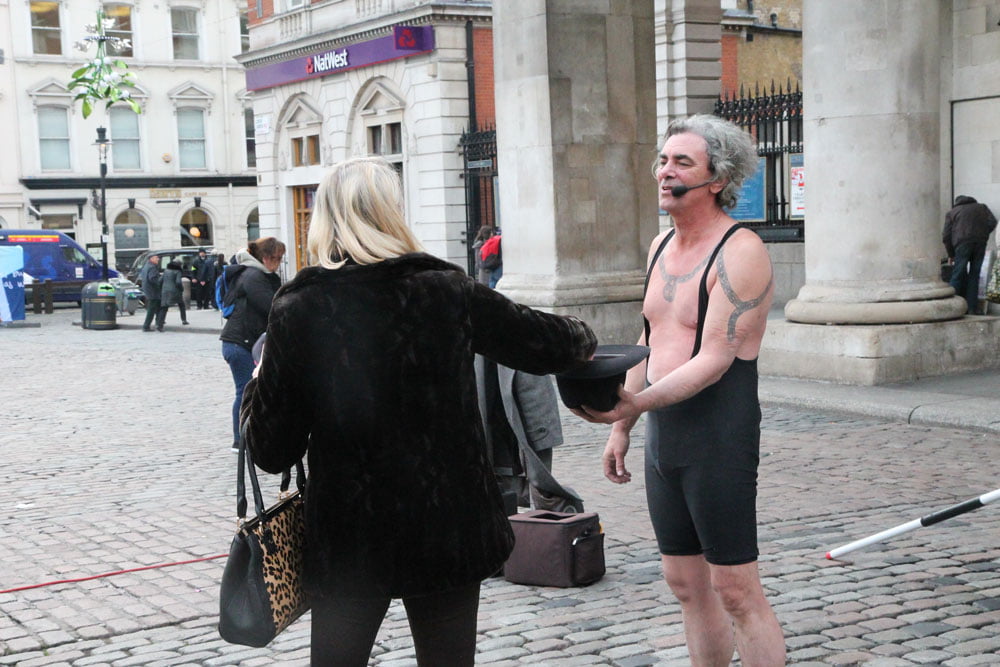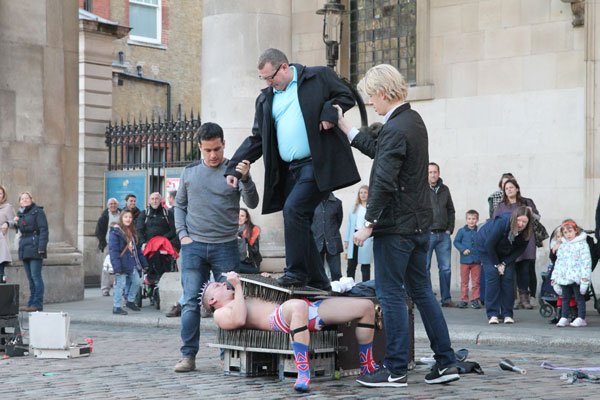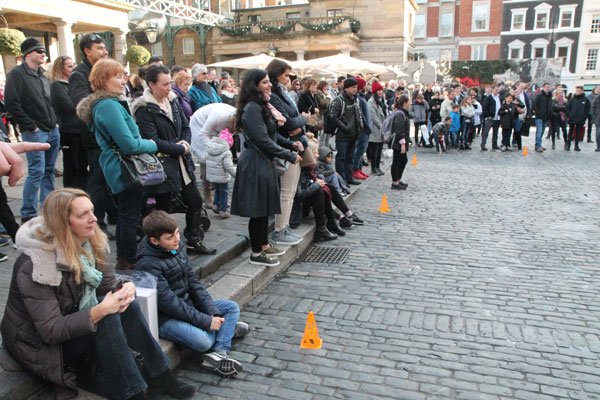What can Business Presenters Learn from the Best Street Entertainers in the World?


There’s a 36 year old guy, married with a mortgage and 3 kids. He stands on a cobbled street in London, asking tourists for money. If they don’t give him money, his kids don’t eat, his rent doesn’t get paid and he has to go and find himself the real job that he’s tried to avoid for his entire life. He’s not a beggar. He’s a street entertainer. You know the type. The brave men and women who keep the crowds happy and laughing in every square, market or ‘garden’, in every major city of the world that has a soul.
In an idle conversation at the Guru wondered out loud what us professional presenters might be able to learn from our street smart cousins. So Jim Harvey and Jared Senseman went out and got to know three of London’s finest: Nick Malinowski, Tony Roberts, and Spikey Will ‘Man of Danger’. Here they share the learning that all of those outdoor shows have given them.
These three street performers have been working the hard pavements for years. They’ve had to audition to get their licences and have had to earn that licence every day by making perfect strangers stop, look, listen, and most importantly for them, pay for the privilege of their performance.
If you do the entire show, and you do the finale and then you see people walking away without even coming to say ‘hi’ or ‘thanks’ or drop in a coin or two in the hat, that’s when it gets depressing.
Some people think stand up comedy is hard. Can you imagine what it’s like to be a street performer? If they don’t chime with the crowd they don’t get a penny. Of course you can imagine what it’s like though, right? It’s not exactly the same as that thing you do, is it? But every time you stand up to make a presentation you’re asking people for something, their time, energy, focus and sometimes their money. So in this article we’re going to learn the secrets of engaging an audience from some of the best street entertainers in the world, because there might be real value in their experience for us, in our warmer, more regular lives.
We’ve broken down what we learned from these guys into four really useful lessons for the corporate speaker. They are practical, simple and immediately useful and we hope you find them as interesting as we did in learning them.
Engaging The Audience
1. Tackle the Dads
“You grab the ones that aren’t particularly into it, and the rest, the ones that are, follow suit. Usually it’s the dad that’s not very interested, so what you do in that situation is you go for the dad. If you can engage the dad, the rest will follow suit.” – Nick
The Lesson
We’ve all been in a room where there’s at least one person on their phone or tablet who couldn’t care less about what you’re saying. As a speaker, it’s all too easy to ignore that person and maintain eye contact with those who are already interested. Nick is saying we should make that one disengaged person our primary target. If you can get him/her, the rest of the audience will follow. So how do you engage that one person who is completely disinterested?
2. Get the Dad to hold the ladder
“At the start of the show, I’ll occasionally bring someone out to hold the ladder for me, and sometimes I’ll do that with a family. I’ll grab the dad, the least engaged member, and the rest of the family is already engaged.” – Nick
The Lesson
Often this means, grabbing the distracted person’s (sometimes it’s the boss’) attention using whatever means that you can before and during the presentation. If you fail to grab the boss’ attention, then you’ll lose everyone.
Contact the boss, and a selection of the key audience members, in advance, via email, phone, face to face or any way that works. Ask them what they want to get out of this meeting. Get their insight into the issues. Listen to the words that they use to frame the topic. Let everyone else know, before, during and after the presentation, that you couldn’t have done this without ‘Dad’s’ help. There’s a balance to be found, since you don’t want to put all the responsibility on the dad’s shoulders, because he might resent it. He might not actively want it. But to start talking to a crowd of strangers without understanding who’s the dad, or mom, is a mistake you won’t want to make more than once.
3. Pique curiosity from the start
“Making big noise, having big dangerous looking props, my hair and my suit are colour-coded with my tie and pocket handkerchief. That’s not so I look good on the train, it’s so that when I go out there, there’s a level of curiosity.” – Will
The Lesson
Think back on your favourite book or movie. Wasn’t there something within the first five minutes that grabbed your attention? Perhaps an interesting backstory, or some sort of action sequence? A glimpse of the future. That’s called a hook, and it’s imperative for any speech or presentation. The Greeks called it a prologue, because the Greeks knew that audiences were impatient. They won’t wait while you unveil act one of your story, because it takes time; whether you’re laying in the hot sun of a Greek evening, or standing in the rain on the cobbled streets of London, or sitting in another sales presentation. The audiences want to know where this is going, because they simply won’t wait for ‘slide 37.’
4. Make the audience comfortable
“It’s one of those real things that you just don’t know. I’ve got a very laid back and comical approach, and it’s more about people feeling comfortable stopping. So once I get my volunteers, the whole show is described through them, so it becomes our show – the three of us. I get people invested in it. It also makes the crowd comfortable, because the audience knows they’re not going to be picked on or called forward to be part of the show” – Tony
The Lesson
Anyone who’s ever seen a live performance knows the horror that comes with being singled out from the crowd. You want your audience to be comfortable enough to sit back and really be able to engage with your message, as opposed to being in fear the whole time that you’ll pick them. There are two main points that can be taken from this:
Don’t criticise the people
If you’re selling an idea or product, there might be an element of implied criticism of the current choices or performance of your audience (or client, in many cases.) Successful salesmanship is about letting them know that you’re not lecturing them, you’re exploring an idea together. You, together, will solve this problem; you, together, will make this work. It’s not just your show, it’s theirs as well. And that’s how you make them feel, part of the act, not its passive victim.
Make them the hero
For the audience, they are the stars of the show. Yes, they expect you to play your part, but they want you to be kind, funny and respectful to them and to their colleagues that you’ve asked to help you. The very best entertainers raise the volunteers up to be the heroes of the act, and are generous to the dads and kids who help them out.
Holding The Audience’s Attention
Most of us, at some point or another, have felt the discouragement that comes from looking out at an audience and seeing them completely disengaged, on their smartphones or tablets, not listening to a single word you’re saying. Now, imagine how hard it is when you’re not in a boardroom, but outside competing with a host of other entertainers who are all trying to fight for a few coins. We asked Nick, Tony, and Will how to keep an audience engaged, and they answered with five key steps:
1. Be fluid
“There’s a certain fluidity to it. You’ve got to go with the flow. Especially in street theatre. It’s something that’s so variable.” – Nick
The Lesson
You have to go with the flow. Be prepared to adapt. Know everything forwards and backwards, but be ready to shuffle your key points around if need be. Each audience will respond differently to a presentation, so be ready to adjust based on their feedback. That’s what makes the difference in speaking at and audience, and speaking to one.
2. Understand the beats in your presentation
“We’ve got a script, and we’ve got certain beats that we’re going to hit each time, but at the same time you’ve got to be flexible within that. You’ve got to have room to play, because that’s what the audience engage with. If you’re just coming out and running a script, they’ll get bored. They can see it in your eyes that’s it’s just something in the back of your head, that you’re not really engaging with it yourself, so why should they? If you’re engaged, and you’re enjoying what you’re doing, people will see that and it becomes contagious.” – Nick
The Lesson
Think of your presentation as a play. You’ll obviously need to know your three acts, and where you plan on taking your audience. If you’re simply stumbling along without a plan, they’re going to know it.
Act one – The setup
Make sure your audience understands the setup of your presentation. Why should they care? What’s in this for them? They want to know that whatever the reason is that they’ve walked into this room to listen to you, is worth their time. You’ve got to let them know that the juice is well worth the squeeze.
“I’m doing stuff all the time during my show, it actually starts with me juggling meat cleavers within the first minute. That alone is a hook, I really believe in doing something during the first bit. What people perceive of street performers is this long constant buildup to something big at the end, but the audience should never really be forced to do that. They need to be continuously entertained from the beginning.” – Will
Act two – The follow-through
When you show the audience a bed of nails, they want to see you on it. They’ll ask, “Where is this going?” and now is the time to start to let them know. It’s your job to know where the beats are, as the audience will only give you three before they grow impatient.
“There’s a structure to it, there has to be a beginning, a middle, and an end, and there has to be a point to it. But how you play is what makes the difference, it’s just like jazz.” – Tony
Act three – The finale
“Each performance is its own performance, but hopefully you’re manipulating the audience enough where they react the way you want them to.” – Tony
What does this mean to your audience? How does it relate to them? This is where it all comes together, the sort of “Eureka!” moment. You’ve kept the audience engaged, you’ve delivered the message, now make sure they understand it, and make sure they take it away with them.
Making the Audience Pay
1. Time is Currency
“A lot of people assume that the audience walking away without paying is rejection, but it’s not. If they’ve stayed for the whole show, they’ve just given me 45 minutes of their time, and that’s not a rejection.”
The Lesson
The audience has already paid by showing up and staying through the show. They’ve given you the gift of their attention, which isn’t a paltry sum in today’s world. As speakers, we’re continuously fighting for the audience’s attention amidst countless digital mediums. If the audience is listening to you, that means they’re not on their phones, and that’s something.
2. If they don’t pay, that’s your fault
“If they walk away without paying, that’s my fault, not theirs. If I haven’t done enough for them to leave a couple coins or a fiver, then that’s not their fault, it’s mine.”
The Lesson
In this case, it’s all about you. You’ve held the audience’s attention for a while now, and if you don’t convert that into a sale, for any reason, then that’s your fault. The audience wants to show their appreciation, but they don’t know how. As with any presentation, you’ve got to tell them how to make the best of this experience. Tell them to how to pay, but give them a choice. Ask for 20 pounds, 10 pounds, 5 pounds, or even a couple of coins.
If it’s not a sales presentation, there’s still the idea, or the change or the matter to be ‘closed’, even if you’re not asking for their money, you might be asking for their help, support, feedback, ideas, or patience. So many presentation don’t finish properly. They leave the audience hanging, thinking ‘what do they want me to do now?’ as the speaker stops talking. That’s a real damp squib, an a missed opportunity. If it’s an idea you’ve explained tell them what you want them to do with it. If you’ve explained a change, tell them how they can help support the change, and what’s coming next.
3. It shouldn’t be about the money
“It’s about starting with an empty square, filling it up with 100 people, and sending them away with their day improved. I’ve made them forget about all the stuff that’s going on, if only for a moment.” – Tony
The Lesson
And at the end of the day, the more you focus on the money, the more obvious that will be to the audience. If you’ve spent a day focusing them on something that can make them better, showing them from one place to another, and then focus on the money in the end, they’ll notice. The more you try and hide your true intentions, the more obvious it becomes. Forget about the money, concentrate on the show, and the money will come.
“For me, the day after the Brexit vote, I did a show in South Bank, and it was amazing because of the diversity of the people that were in the audience. A Palestinian, a Polish guy, a girl from South Africa – it was the U.N. of street shows. And to be able to pull that many people together and unite them with laughter is way more important than what goes in the hat and the end of the show.” – Tony
Dealing with Rejection
The final lesson we learned from our talented street entertainers came from their ability to handle rejection. As presenters, we’ve all had that one presentation that simply didn’t go as well as we’d hoped. Discouragement is a difficult thing to overcome in these situations, and the ability to pick ourselves back up and learn from them is imperative to becoming a better speaker.
1. When they walk away
“It’s simply rejection. It does happen – It happened in my last show, a few people walked away. It’s fair enough, I mean, it’s street theatre.” – Nick
The Lesson
Sometimes, no matter how great a speaker you are or how lively your show is, you’ll have audience members who simply won’t engage with you, your idea or anything to do with it. It wouldn’t matter if you lit a fire on stage while screaming at the top of your lungs, there are those who just won’t ‘be there’. Which is fair enough, as we’ve all had those days where we’ve got something going on in our personal lives that keeps us from really being able to listen. It’s part of life, and part of the speaker’s journey.
2. It’s not just rejection, it’s feedback
“It basically signals that there’s something you’re doing that isn’t engaging them, so it gives you the impetus to keep doing the show. It’s constructive criticism.” – Nick
The Lesson
When it turns from a handful of people being disengaged to a large portion of your audience, you know that you’ll need to change the performance up a bit. John Zimmer recently wrote about jotting down notes immediately after giving a presentation. What went well? What went wrong? What could have gone better? Don’t let rejection be a discouragement, let it be a motivator.
3. It’s your job to engage the audience
“It’s not their job to be entertained by me, it’s my job to entertain them, and what I get to do is a gift. And for every person who walks away, there’s another person who’ll leave a ten or a twenty.” – Tony
The Lesson
When you walk into a boardroom or onto a stage and see people waiting for you to speak, that means the audience has already done their job. They’ve shown up. Now it’s your job to keep them there, and to keep them listening.
Conclusion
Nick, Tony, and “Spikey” Will are on the ‘front line’ when it comes to dealing with an audience. They work yearlong, sunshine and sleet, meeting completely new sets of strangers everyday. We’ve done our best to listen and learn as much as possible from them so that you, as speakers, might incorporate something of their wisdom into your next pitch. We want you to be able to engage your audience as much as they do. We want you to be able to convince them to buy in as much as they do. We want you to stand out, every time you stand up to speak.
Let’s leave the very last word to Spikey Will, Man of Danger.
“Yes, on a Tuesday morning in February I’ll still be doing this show to earn my money, grinding it out for a few measly pounds, but on a day like this, or days like when I perform at the Edinburgh Festival, I get to go out and hear the people chant my name. I’m 36 years old, and I’ve been performing since I was about 8, and without it, I truly wouldn’t be happy.”
We’ve got lots more hints and tips on how to perform better in your next presentation. There’s huge amounts of wisdom here too about presentation design, storytelling and presentation technology.

















